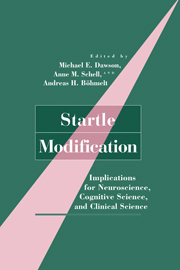Book contents
- Frontmatter
- Contents
- Contributors
- Preface
- Prologue: A Historical Note on the “Discovery” of Startle Modification
- 1 Startle Modification: Introduction and Overview
- PART I BASIC PARADIGMS, METHODS, AND PHENOMENA
- 2 Startle Elicitation: Stimulus Parameters, Recording Techniques, and Quantification
- 3 Short Lead Interval Startle Modification
- 4 Long Lead Interval Startle Modification
- PART II PHYSIOLOGICAL MEDIATION OF STARTLE MODIFICATION
- PART III PSYCHOLOGICAL MEDIATION OF STARTLE MODIFICATION
- PART IV INDIVIDUAL DIFFERENCES AND STARTLE MODIFICATION
- PART V RELATIONSHIPS WITH OTHER PARADIGMS AND MEASURES
- References
- Author Index
- Subject Index
3 - Short Lead Interval Startle Modification
Published online by Cambridge University Press: 26 March 2010
- Frontmatter
- Contents
- Contributors
- Preface
- Prologue: A Historical Note on the “Discovery” of Startle Modification
- 1 Startle Modification: Introduction and Overview
- PART I BASIC PARADIGMS, METHODS, AND PHENOMENA
- 2 Startle Elicitation: Stimulus Parameters, Recording Techniques, and Quantification
- 3 Short Lead Interval Startle Modification
- 4 Long Lead Interval Startle Modification
- PART II PHYSIOLOGICAL MEDIATION OF STARTLE MODIFICATION
- PART III PSYCHOLOGICAL MEDIATION OF STARTLE MODIFICATION
- PART IV INDIVIDUAL DIFFERENCES AND STARTLE MODIFICATION
- PART V RELATIONSHIPS WITH OTHER PARADIGMS AND MEASURES
- References
- Author Index
- Subject Index
Summary
ABSTRACT
This chapter deals with the modification of startle caused by a lead stimulus presented at a lead interval of less than 1 s. This modification of startle can be affected by a variety of parameters of the lead stimulus, such as duration, intensity, and lead interval. Startle modification at short lead intervals can also be affected by the intensity of the startle stimulus itself. The modification of startle decreases as a testing session progresses, and this is due either to habituation of the inhibitory mechanism or to a decrease in control startle reactivity. In some cases, lead stimuli can facilitate the startle response at short lead intervals, usually when the lead and startle stimuli are presented in different sensory systems. Short lead interval modification of startle may serve to protect the processing of the lead stimulus from interruption, but this reflex modification also illustrates automatic sensory gating and the influences of attentional mechanisms early in stimulus processing.
Introduction
The startle reflex can be elicited by sufficiently sudden and intense stimuli in several sensory modalities, and this reflex has been studied in a wide variety of animals, including humans, across the life span (see Chapter 2). Graham (1975) suggested that the modification of the startle reflex could be useful in identifying the neural mechanisms, at several levels of the central nervous system, that underlie a variety of information-processing functions (see Chapter 1). This chapter will focus on the effects of lead stimulus presentation or change on startle responding, when those lead stimuli are presented within a few hundred milliseconds of the startle stimulus.
- Type
- Chapter
- Information
- Startle ModificationImplications for Neuroscience, Cognitive Science, and Clinical Science, pp. 51 - 71Publisher: Cambridge University PressPrint publication year: 1999
- 46
- Cited by



